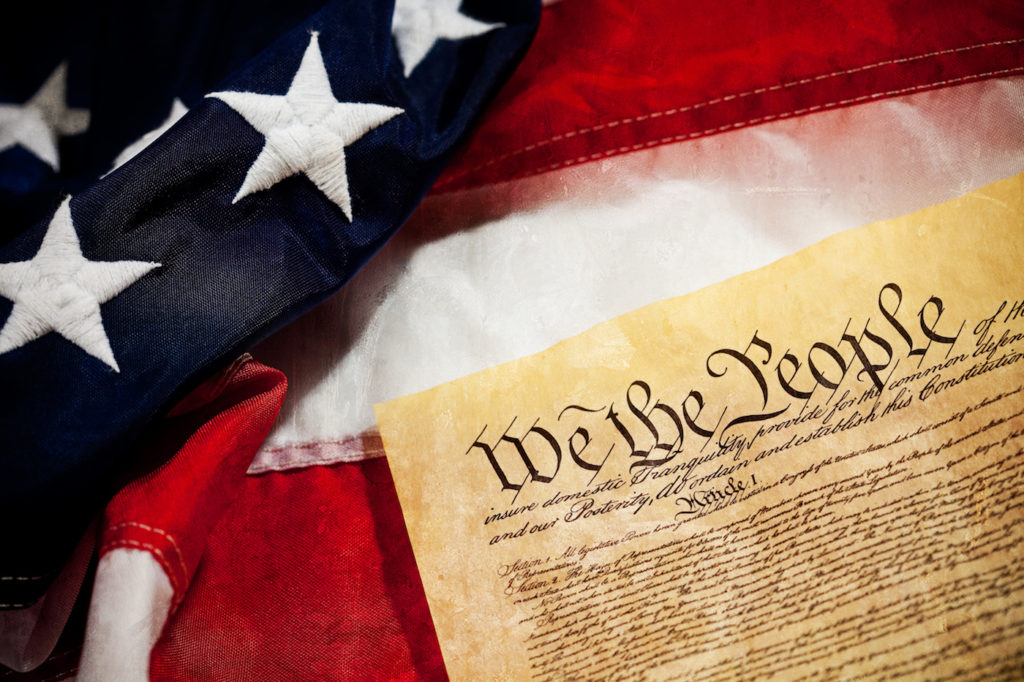The question of whether the federal Constitution should be construed as a document about slavery, as much as governance, is not a new one. The last of the Constitution’s authors was still alive when William Lloyd Garrison denounced the Constitution as an “infamous bargain” that coddled and favored slavery, trampling under foot the “solemn and heaven-attested Declaration [of Independence], that all men are created equal.” Frederick Douglass was even more explicit in connecting the Constitution and slavery during his Garrisonian days in the 1840s, itemizing the three-fifths clause, the twenty-year breathing-room given to the importation of slaves, the fugitive slave clause, and even the provisions for suppression of domestic insurrection as deliberately written to befriend slavery.
But the argument that the Constitution contained an explicit bias in favor of slaveholding has taken on a particular force in the last twenty years through the work of Paul Finkelman, David Waldstreicher, George Van Cleve, and George P. Fletcher. They have developed the Garrisonian indictment into an even longer list of evidences for pro-slavery favoritism: the Electoral College and the assessment of direct taxes (both of which are calculated by using the three-fifths clause), the ban on export taxes (to favor cotton as an export commodity), and the limitation of civil suits and “privileges and immunities” to “citizens” (Article 3, Section 2). “A careful reading of the Constitution,” Finkelman insists, “reveals that the Garrisonians were correct: the national compact did favor slavery … No one who attended the Philadelphia Convention could have believed that slavery was temporary.” Similar arguments are made by David Waldstreicher, who notes that “Of its eighty-four clauses, six are directly concerned with slaves and their owners,” while “five others had implications for slavery.” In fact, Waldstreicher adds, the motivation for many of the Founders in their Revolution was a desire to protect slavery from what they perceived as increasing British imperial hostility to it, beginning with the Somerset decision in 1772. Hence, in “growing their government, the framers and their constituents created fundamental laws that sustained human bondage.”
Taken in the best light, this construction of the Constitution as a pro-slavery document is a reminder that the writing of the Constitution occurred at a particular cusp in the life of Western political thought. For the first time, the idea that a portion of the human family could be consigned to a permanent status of forced labor, without any claim to standing in law, began to be seen as somehow repugnant. For virtually all of prior human history, slavery had been seen as little more than a simple fact of life, as unpleasant but as unavoidable as death and taxes. As Gordon Wood remarked, until the mid-eighteenth century, “as long as most people had to work merely out of poverty and the need to provide for a living, slavery and other forms of enforced labor did not seem all that different from free labor.” It required the tremendous overthrow of notions of hierarchy and status by the Enlightenment even to begin to question the institution of slavery with the same energy that other apparently permanent institutions like monarchy were being questioned. That the Constitution should, at such a hinge moment, still retain carry-overs from less enlightened times should not, therefore, be a surprise. However, it is also true that what makes the Constitution remarkable is not that, at such a moment, it contained provisions that seemed to offer guarantees to slavery, but that it contained so few of them, and that the debates in the Constitutional Convention over the continued existence of slavery in the new republic should have been so vehement.
Taken in its worst light, however—which is largely the light in which Finkelman and the modern Garrisonians understand it—the Constitution is a deeply tainted, deeply flawed, and indefensible instrument of governance whose product, for at least eight decades, was the protection of an abomination. The neo-Garrisonian complaint has the advantage of moral fervor, but it also has the unfortunate resonance of an argument that would claim that the designers and builders of the Titanic deliberately constructed the doomed ocean liner specifically with a view toward sheering into an iceberg and drowning 1500 unsuspecting people.
Start your day with Public Discourse
Sign up and get our daily essays sent straight to your inbox.Don Fehrenbacher’s 2002 book The Slaveholding Republic: An Account of the United States Government’s Relations to Slavery was a timely reminder that the intentions of the Constitution’s authors, and the subsequent wresting of control of the republic’s leadership by slaveholders, were two very different matters, to be confused at our peril. Fehrenbacher, in reviewing the work of the Constitutional Convention, dismissed the idea that the Convention ever permitted “the intrusions of slavery” except as “side effects of progress toward a new constitutional design.” If anything, the Founders “believed or hoped that somehow in the flow of time, slavery would disappear,” especially once the abolition of the slave trade came into effect. “The imprint of that expectation is visible in the document they finally approved.”
No Property in Man
Princeton Professor Sean Wilentz’s No Property in Man is another forceful reminder of how those intentions crystallized around the conviction (as James Madison put it) that it would be “wrong to admit … the idea that there could be property in men.” Wilentz reminds us of four basic elements that present strong evidence against the neo-Garrisonian interpretation:
- that the Constitution was written at a hinge moment in Western culture, and is more remarkable for the degree to which it refuses to give countenance to slavery than for any provisions that could sustain it;
- that the Constitutional Convention’s debates over slavery and its influence were lengthy, bitter, and far from satisfactory to the minority that sought explicit protections for slavery;
- that the Constitution spawned an ongoing struggle over the legitimacy and expansion of slavery over the succeeding seventy-eight years; and
- that the ultimate abolition of slavery was accomplished at the hands of people who argued with as much energy as the Garrisonians that the Constitution was, in fact, an anti-slavery document in which freedom was the national norm and slavery only a localized aberration.
It is on this last point that the neo-Garrisonians have some of their heaviest lifting to do. James Oakes has laid out in spacious detail how anti-slavery Republicans in the 1850s argued that, since the Constitution gave slavery no explicit sanction—and gave the federal government no power to intervene in it in the states—slavery could only be a matter of state legislation and action, while the Constitution as a national document assumed freedom to be the rule in all national affairs. Hence the Republican slogan, Freedom national, slavery sectional. “Our fathers,” said Massachusetts Senator Charles Sumner, “did not recognize slavery as a permanent part of our system, but treated it as exceptional and transitory.” This excision of the term slavery was deliberate, added Missouri Senator H. Gratz Brown, “to exclude from that Constitution any national recognition of slavery, to avoid any national obligation to foster or protect it.” If slavery seemed to enjoy constitutional protections, it was only because a slaveholders’ conspiracy—the “Slave Power”—had cleverly hijacked the federal government and twisted interpretation and application of the Constitution to their purposes. “The slaveholders,” wrote Illinois Congressman Isaac Arnold, “now united and became a compact, active, determined, overbearing, despotic, unscrupulous power” that “monopolized the offices of power, profit, and influence under the government.”
Above all, Abraham Lincoln insisted that the cold refusal of the Constitution to mandate the legitimacy of “property in man,” as well as the supervision over the federal territories that it gave to Congress, were living proofs of the Constitution’s anti-slavery intent. “The effort to prove that our fathers who framed the government under which we live” somehow did not “forbid the federal government to control slavery in the federal territories, is as if, when a man stands before you, so that you see him, and lay your hand upon him, you should go about examining his tracks, and insisting therefrom, that he is not present, but somewhere else.”
This refusal to see that the persistence of slavery grew, not out of the Constitution itself, but out of slaveholders’ refusal to follow the Constitution’s leading on the subject, led Lincoln to ridicule the notion that the Constitution ever condoned slavery. “It was not we, but you, who discarded the old policy of the fathers,” Lincoln said in his Cooper Union speech of February 27, 1860. “We resisted, and still resist, your innovation; and thence comes the greater prominence of the question.” Lincoln was indignant at the assertion that the Constitution somehow guaranteed slaveholding as a right. “No such right is specifically written in the Constitution. That instrument is literally silent about any such right. We, on the contrary, deny that such a right has any existence in the Constitution, even by implication.”
Neither the word “slave” nor “slavery” is to be found in the Constitution, nor the word “property” even, in any connection with language alluding to the things slave, or slavery, and that wherever in that instrument the slave is alluded to, he is called a “person;” and wherever his master’s legal right in relation to him is alluded to, it is spoken of as “service or labor which may be due,” as a debt payable in service or Labor …
And the fundamental premise on which Lincoln built this assertion is the same as Madison’s: “this mode of alluding to slaves and slavery, instead of speaking of them, was employed on purpose to exclude from the Constitution the idea that there could be property in man.” In that respect, Professor Wilentz’s book is itself one long Lincolnian statement of the Constitution’s direction.
For the neo-Garrisonian critique of the Constitution to stand, we must assume that all of these voices, from Madison to Lincoln, were wrong—wrong in how they understood the Constitution, wrong about slavery, and wrong about the basic issue Professor Wilentz places in the path of the neo-Garrisonians, that that Constitution gave no sanction to the fundamental pro-slavery proposition that there could be property in man. This does not mean that Garrison or his modern avatars are themselves wrong about slavery itself—they are not, and that is the great strength of their critique—or that the Constitution is a stainless and perfect confection. There was an opportunity in 1787 to have torn up slavery by its roots, to have cured the republic’s single greatest birth defect while it was yet in its infancy, and that opportunity was missed. But the missing came as much through overconfidence that the march of opinion would wipe out slavery on its own, and as much through the miscalculations of political compromise, as through any conscious policy to foster or promote slavery. Absent the basic embrace in the Constitution of any notion that there could be “property in man,” slavery was a rootless weed—noxious in its nature and quite capable, like poison ivy, of imposing immense misery, but lacking any essential sustenance there.














